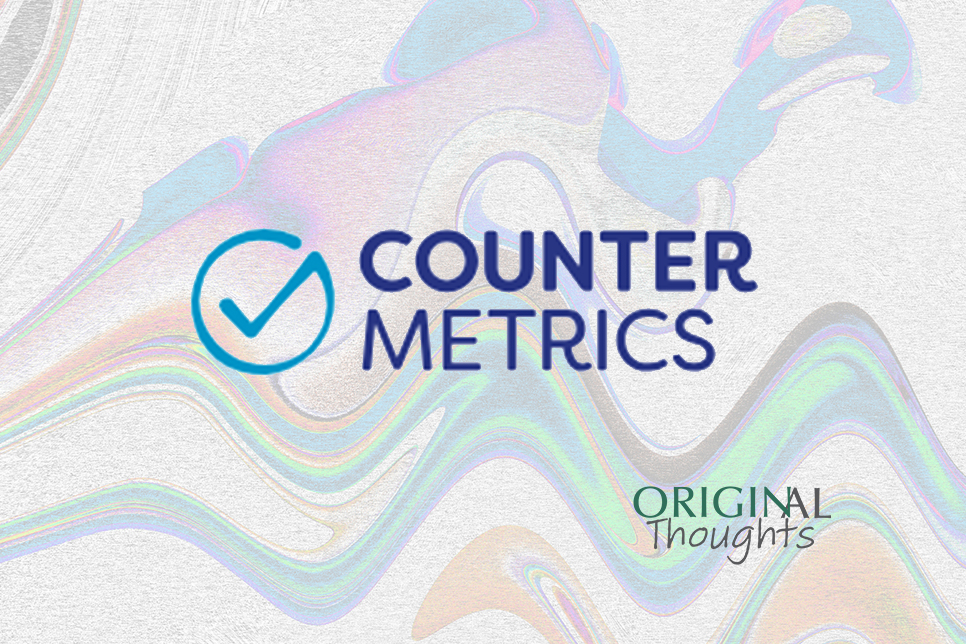First posted on the ORIGINal Thoughts Blog
Tasha Mellins-Cohen (left)
Executive Director
COUNTER Metrics
Siân Harris (right)
Communications and Engagement Manager
COUNTER Metrics
COUNTER Metrics LinkedIn: linkedin.com/company/countermetrics
bsky: @countermetrics.bsky.social
Take Home Points:
Who Built COUNTER?
In the early years of digital content, every publisher measured usage differently and librarians didn’t know what measures to trust. Peter Shepherd, with his background as a publisher with Wiley, Pergamon, Elsevier and Harcourt, recognized this challenge and gathered a group of librarians and publishers to create a shared standard for measuring online content usage. The result became COUNTER. Since 2003 COUNTER has been led by and for a collaborative group of libraries, consortia, publishers, and aggregators, operating under a not-for-profit model funded primarily by membership fees. Our mission is to bring the knowledge community together to agree on and adopt the global standard for measuring and reporting content usage through normalized metrics.
Sounds Great, but What Does That Mean?
Measuring the impact of scholarship is essential for evaluating the return on investment in research and publishing, understanding the research landscape, and making informed decisions about future funding, research, and editorial strategies. COUNTER is an open, community-created standard that allows usage to be compared across different publisher platforms and over time, and explicitly requires that bot usage be excluded from counts. By contrast, web analytics are often opaque in the way they track usage, and what’s measured can vary without explanation as their operators adapt to meet changing commercial conditions—for example, many web analytics services now appear to track usage by AI training modules in the same way as they do usage by human users. COUNTER is also privacy-protective by design, where web analytics systems typically track users as well as usage.
Why Should We Care?
Alongside citations and altmetrics, usage forms part of a suite of metrics that can complement holistic research assessment.
Where citations take a long time to appear in the scholarly record, usage accrues from the day of publication. Equally, altmetrics are changing as the social media landscape shifts, where usage patterns change to reflect the activity of scholars. To get the best from usage as a measure of impact, however, we must be sure to compare like with like: the usage metrics must be based on normalized criteria for tracking and reporting activity, ideally driven by an open standard that is controlled by the community and subject to audit. That is precisely what COUNTER offers.
What Does COUNTER Count?
There are three types of metrics in the COUNTER Code of Practice: usage metrics, search metrics, and denial metrics.
The usage metrics fall into two categories. The first, Investigations, are counted every time a user interacts with a piece of content on a publisher site. That might be an article abstract or full text, a book chapter preview or the chapter PDF, a video thumbnail, or whatever else the site hosts. Requests are a subset of Investigations that are counted only when a user interacts with a complete piece of content–from the list above, you would count 1 Investigation and 1 Request if a user chose to access the full text of an article, download a book chapter, or hit play on the video.
Beyond usage metrics, COUNTER also covers Search and Denial metrics. These are exactly as they sound: they measure the number of searches conducted on a publisher website, and the number of times a user is denied access to a piece of content.
COUNTER usage metrics are traditionally delivered to institutional libraries via one of four reports:
- Super-detailed article- and chapter-level usage and denial metrics in the Item Reports (IR)
- The always-popular Title Reports (TR), which roll up the usage and denial metrics from the IR to more usable journal- and book-level information.
- The Database Report (DR), equivalent to a TR but for databases and with the inclusion of search metrics.
- A birds-eye view across entire publisher platforms in the Platform Report (PR).
There’s a lot more information about our metrics and reports on COUNTER’s free Education pages, and you can find a complete set of sample COUNTER reports in the Code of Practice.
What About Open Access?
COUNTER’s Global versions of the IR and TR are optimized for open access (OA). They use the same standardized processing as any other COUNTER report, which means your OA metrics are credible and comparable with other publishers worldwide. Instead of being limited to a single institution, Global reports combine non-attributed and attributed usage of content on publisher platforms—that is, the usage we can link to institutions, and that which we can’t link to institutions, wherever they are in the world. Within that split, whether content is paywalled or free to read or OA is a secondary question.
Depending on what you are trying to achieve, Global reports will allow you to compare overall usage of licensed and open content, broken down by country if the publisher tracks that information. For a full-open access journal, the Global TR is great, while for publishers offering article processing charges or bundle deals, where open access is paid for or configured at the article level, the Global IR is ideal.
How Are COUNTER Metrics Used?
There are lots of ways that libraries can use COUNTER metrics, including calculating cost per use for existing holdings, deciding on whether to subscribe to or buy new content, cancellation considerations, and of course management reporting.
Because of the connection with purchases and cancellations, COUNTER has historically been treated as a sales tool, but publishers and editors can and should use it as the valuable business intelligence it is. The benefit to using COUNTER internally is that it socializes the language around usage—everyone speaks the same language as your customers. If an editor meets a librarian at a conference, they won’t be speaking at cross-purposes around usage.
- Here’s a brief rundown of how we’ve seen COUNTER reporting being used within publishing houses, beyond sales:
- Editorial can use COUNTER metrics as part of their content development strategy. If a particular journal or set of articles is seeing high usage generally, it could be an idea to commission more on that topic. If the usage is coming from a specific institution, that might be a source of new authors or reviewers. Equally, a spike in denials for a particular topic can be an indication of something novel—for example, some virology journals reported a spike in denials for articles on coronaviruses in late 2019.
- Tech teams can use COUNTER metrics to identify flaws in the user experience, or to build a business case for investment in developments.
- Marketing can track COUNTER usage either institutionally or globally to provide evidence of the effectiveness of usage campaigns, They could also plan campaigns to boost usage from specific institutions.
Parting thoughts
We know that technical standards aren’t the most riveting of topics, but accurate, trusted usage metrics are an important aspect of journal performance. Ask your tech teams to share your journals’ COUNTER reporting with you, and use the information provided as part of your development process.
Origin Editorial is now part of KnowledgeWorks Global Ltd., the industry leader in editorial, production, online hosting, and transformative services for every stage of the content lifecycle. We are your source for society services, market analysis, intelligent automation, digital delivery, and more. Email us at info@kwglobal.com.






